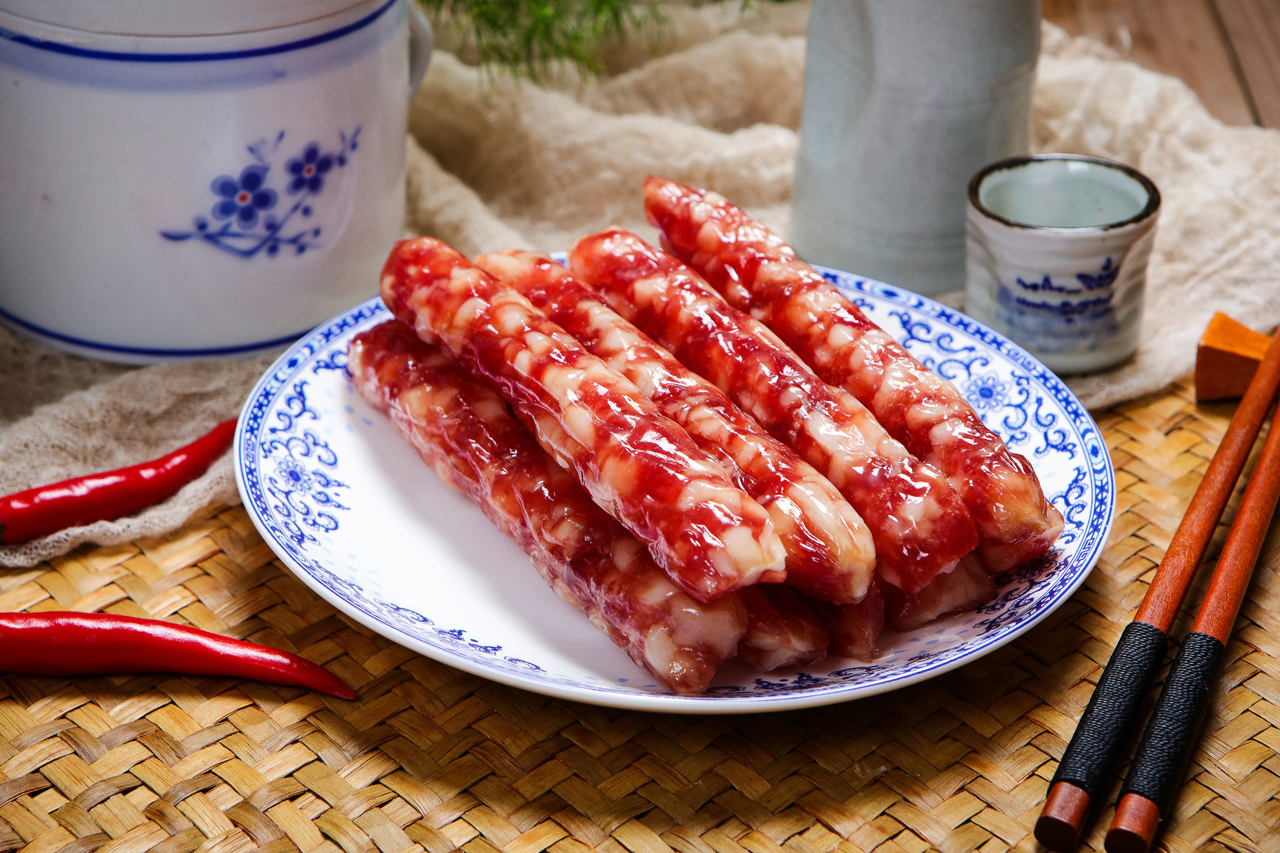
Biting into a piece of lap cheong, or Chinese sausage, brings a flood of tastes and textures to the palate: the slight snap of the thin casing quickly yields to a wash of fatty meatiness and a vaguely soft salty flavour that lingers in the mouth.
As with much of the cuisines of China, lap cheong varies by region and the generic Cantonese term can even cover dried sausages from different countries in Asia. In North America, lap cheong commonly refers to the pork variety with a deep pink colour, while yun cheong is made with pork and duck liver and is darker brown with a deeper, more savoury flavour. Both types are made with coarsely ground or chopped meat in casing using a salt and sugar cure before being air dried (or, poetically, “wind dried”). The result is a firm, slightly sweet sausage that must be cooked before consumption, much like a raw chorizo.

These two varieties can be sold individually or packaged together with a dried, bacon-like pork belly product, and can be found in most Chinese supermarkets or grocers.
Storing Chinese Sausages
Although lap cheong and yun cheong are shelf-stable and sold vacuum-packed on store shelves, once the packaging is opened it is best to keep them in the refrigerator. Lap cheong has a relatively long shelf life (weeks in the refrigerator and months in the freezer) but should be cooked before the expiry date on the label and before it shows any sign of mold.
Chinese Sausage Cooking Methods
As versatile as bacon with the same fat and salty notes, lap cheong and yun cheong have similar cooking methods and can be enjoyed on their own simply steamed or used as a flavouring in small quantities for rice, noodles or stir-fried dishes. In recipe books ranging from the iconic All Under Heaven to my mother’s well-worn book of Chinese-American recipes from the seventies, the best methods for enjoying Chinese sausage are often the simplest.
Steaming Chinese Sausage
Steaming the sausages, either by themselves or over rice, is a traditional way to enjoy the purity of the flavours and the plump texture of the meat. Although the instructions on the packaging may differ, an easy way to steam the sausages is to lay them in a single layer on a heatproof plate, then put the plate on a metal rack over simmering water. Steam for at least 20 minutes, although if you forget them for an hour, as a family member discovered by accident, the sausages will still turn out fine.

Steaming Chinese Sausage on Rice
For something slightly more substantial, but no harder, bring white rice to a boil (using this method for a perfect pot of rice on the stovetop), then place the uncooked sausages on top of the rice before reducing the heat to low for the final simmer. Want to ante up the flavour some more? Bite-sized pieces of uncooked chicken, green onions or pre-soaked shiitake mushrooms are also savoury additions to this easy rice dish that make for a cozy meal for winter months. (While you’re soaking the mushrooms, the chicken can be tossed in a marinade of equal parts of soy and rice vinegar, with slightly less white sugar.) If you’re set on a sauce, use light soy, ginger and sesame oil to finish it off, or for lovers of spice, a non-traditional dollop of gochujang, sriracha or chilli crisp would add a bit of heat.

Chinese Sausage Stuffed Vegetables
In love with stuffed squash? Some Chinese cooks put a North American spin on Chinese sausage by cooking the rice, frying it quickly with sliced lap cheong and cooked chestnuts and then filling butternut or kabocha squash with the mixture for a substantial side dish or entree.
Chinese Sausage Stir Fry
Speaking of stir fries, lap cheong and yun cheong are perfect additions to add a little savoury, salty umami to all manner of wok-based dishes. Slice the uncooked sausages thinly on a bias to increase the contact ratio on the heat for added crispiness and use them to flavour vegetables from boy choy to gai lan. They can also be added to pan-fried noodles such as e-fu mein, chow mein, rice or egg noodles. Think of flavour pairings and contrasts — the slightly sweeter lap cheong can be a nice contrast to slightly bitter or acidic greens, while the darker, more savoury liver based yun cheong stands up well to more aggressively flavoured ingredients and sauces.
However you prepare your Chinese sausages, the best way to figure out your preferences is to buy a pack and experiment with techniques and flavours. From simple to sophisticated plates, these versatile ingredients are well worth adding to your arsenal of cooking techniques.
*Note: All Chinese names in this article are English phonetic translations of the Cantonese terms and may vary in terms of spelling, depending on the recipe, producer or grocer.
Images courtesy of Getty Images
